Skeletons retrieved from Welsh coastline in rescue excavations
15 November 2019

Coastal erosion and climate change expose human remains on southeast coast of Wales
The skeletal remains of at least six individuals from the distant past have been saved from coastal erosion in eight days of rescue excavation by a team of experts on the Vale of Glamorgan Heritage Coast.
Archaeologists from Glamorgan-Gwent Archaeological Trust (GGAT) and Cardiff University teamed up with experts from Natural Resources Wales to excavate the remains eroding from the cliff edge at Cwm Nash in a race against time and the elements.
Initial findings suggest the group may have been the victims of shipwreck.
Leader of the excavation for GGAT Paul Huckfield said: “This is the largest rescue excavation undertaken in this area and demanded the collaboration of a team of experts to save these remains and to tell the stories of the individuals involved.”
Professor of Bioarchaeology Jacqui Mulville, who led the Cardiff University team, added:
“Many of the skeletons have lost bones to the sea, but early analysis of the burial positions of the individuals has been revealing. There is a single younger individual, buried away from the rest, with others buried side by side or even together in a single grave. Our latest thinking is that these are Tudor or Stuart men who may have been the victims of shipwreck. We aim to tell more of their stories and return their identities to them through ongoing post-excavation analysis.”
Investigations of two further graves yielded no remains, with coastal erosion the victor.
Previous radiocarbon dating of individuals recovered from the Cwm Nash cemetery has placed those found as late sixteenth or early seventeenth century, living in early modern period of the Tudors and the Stuarts. The earliest burial licence for the parish of Monknash, in which the discoveries lay, was granted in 1609.
The intricate excavations were conducted over three days in July and five days in September in changeable conditions along the edge of the eroding cliff. Local high ropes experts The Adventure Alternative ensured the expedition was conducted safely. Geologists and ecologists from Natural Resources Wales advised on progress of the project in a Site of Special Scientific Interest.
Professor Mulville led the nine-strong team of Cardiff archaeologists, Adelle Bricking, Ciara Butler, Katie Faillace, Eirini Konstantinidi, Michael Legge, Hanna-Marie Pageau and Tiffany Treadway (all PhD students) and MSc Archaeological Science student Lois Turnbull, alongside local landowner and archaeologist Dr Richard Hubbard.
Bioarchaeologists at the University will be carrying out detailed analysis of the human remains into 2020.
Preliminary results focused on the first excavated individual will be revealed in the eighth series of BBC Four’s Digging for Britain on 20th November.




